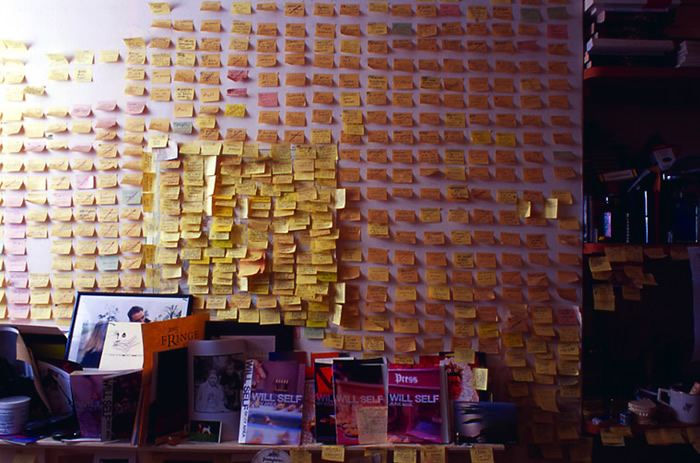Baudelaire writes, “Mainte fleur épanche á regret/Son parfum doux comme un secret/Dans les solitudes profondes.” And George Dillon translates, “Many a flower has bloomed and spent/The secret of its passionate scent/Upon the wilderness profound.” I stand outside La Belle Équipe on the corner of the rue Faidherbe and the rue de Charonne staring down at the great tattered mess of handmade cards, poesies, rotting bouquets wrapped in cellophane and hundreds of little aluminium sockets that once held the stumps of tea lights. A fortnight ago, at about 9.30pm, two gunmen opened fire on the people who were sitting and drinking on the café’s terrace. When they stopped, 19 were dead and nine more were critically injured.
I’m with a small group of postgraduate students from the University of London’s Paris conservatoire; they are doing a Master’s that takes as its subject matter the city itself, and my sessions alternate between the seminar room and themed promenades. Before 13 November the plan had been to examine the traces of political violence in the city’s built environment by walking the sites of the May 1968 événements – the area around the Sorbonne, the rue Saint-Jacques and rue des Écoles – where students tore up the cobbles to throw at the police, thereby discovering the beach beneath the street. Obviously there had been some soul-searching after the attacks: to pretend they hadn’t taken place would be absurd; yet might it not be crass, exploitative even, to shoehorn them into our syllabus?
I stand ready to be corrected, but I don’t remember these bricolage shrines being assembled in the years before Diana Spencer’s death in August 1997. The evening after it happened I joined the silent crowds shuffling through Kensington Gardens and watched, awed, as great barricades of blooms, cards and stuffed animals shivered into being. Ever since, all kinds of fatalities – accidental and malicious, multiple and singular – have been so honoured. It’s as if we have decided, collectively yet tacitly, to confound Baudelaire’s gloomy aperçu. The flower stands as an obvious symbol of the transitory nature of human life; yet by ranging them thus, in their thousands, we seek to defy the wilderness of our own extinction, and our sense of insignificance in the paved deserts and concrete canyons of the city. For is it not the case, that whether we’re sitting on the terrace of La Belle Équipe or powering through the Pont de l’Alma underpass, we are no more substantial than the shadows thrown by the overarching buildings?
Even so, the scent of some flowers lingers longer than others; in the days following the Paris shootings a few voices were raised in the British press – voices that had the temerity to observe: no, this wasn’t the worst massacre on the streets of Paris since the Second World War. That dubious distinction belongs to the estimated 200 Algerians who were rounded up by the police on 17 October 1961 and beaten to death. Some were despatched on the streets where they had been protesting against arbitrary arrest and torture; others were killed at police stations, or in the sports arenas where they had been taken. Many of their bound corpses were thrown unceremoniously into the Seine.
Crowds form and swell and march and shout and scream; crowds stream and course and cataract through the streets; crowds irrigate the great tree of state and the red rose of revolution alike. Paris is a city built in concentric rings, each one another defensive barrier against the marauding hordes from without; the ninth and last of them is the Périphérique, where Diana died. Paris is also a city where town planning has been enacted as a form of state security, so beset have successive regimes been by the maddened mob. Haussmann’s boulevards, either radial or forming grids, were devised with the express aim of making it possible to maintain the city in a state of emergency, and under martial law.
This has now come to pass. In The Eighteenth Brumaire of Louis Napoleon, Marx compared the dictator unflatteringly to his uncle: “Hegel remarks somewhere that all great world-historic facts and personages appear, so to speak, twice. He forgot to add: the first time as tragedy, the second time as farce.” De Gaulle, tragically, brought back the Nazi collaborator Maurice Papon to command the Paris police in the years leading up to the massacre of the Algerians; farcically, since 13 November, the M’sieur Hulot who now tenants the Élysée Palace has unleashed his own jet-powered dogs of war to scent-mark a territory contested from time out of mind.
I’m still standing outside La Belle Équipe – still looking at the terminal and flowery moraine. Later that afternoon, we took a lift to the panoramic terrace of the Institut du Monde Arabe and gazed out over the rumpled roofscape of inner-city Paris, and it appeared to me like a great tattered mess of handmade cards, poesies, rotting bouquets wrapped in cellophane and hundreds of little aluminium sockets that once held the stumps of tea lights. Only the teams we support are beautiful; only the results of their matches are worth remembering. The rest rot unrecalled.
